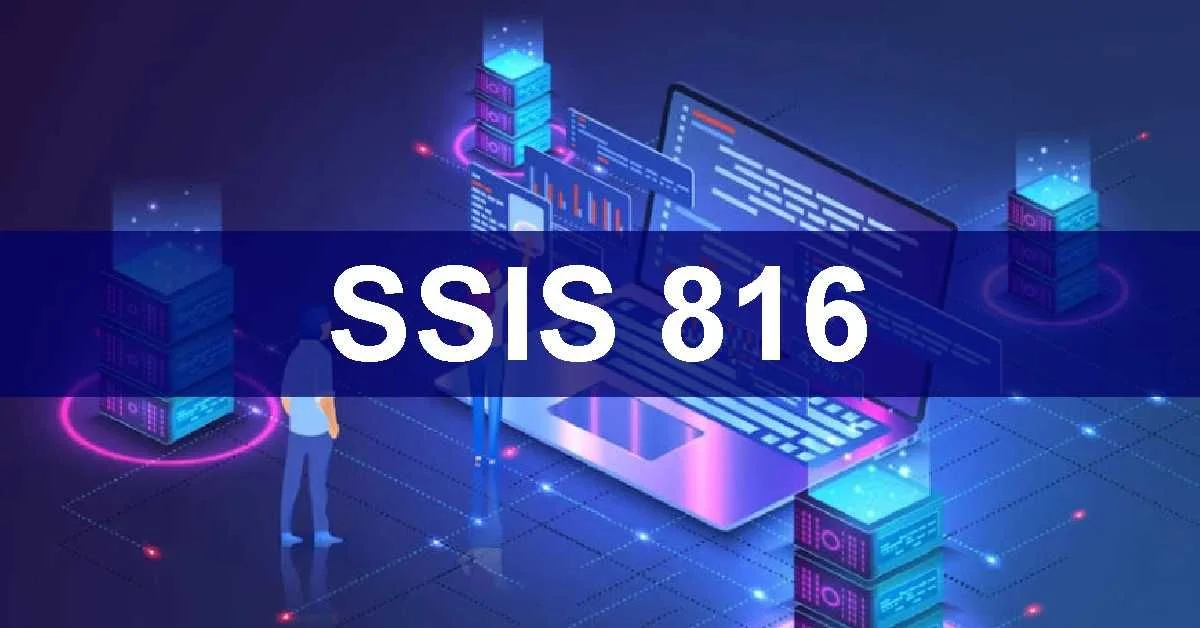Introduction to SSIS 816
Are you ready to take your data integration skills to the next level? Welcome to the ultimate guide on mastering SSIS 816! In this blog post, we will explore the ins and outs of SSIS 816, uncovering its importance in today’s data-driven world. Whether you’re a seasoned developer or just dipping your toes into the world of SQL Server Integration Services (SSIS), buckle up for an exciting journey toward becoming an SSIS 816 expert!
The Importance of SSIS 816 in Data Integration
Data integration is the backbone of modern businesses, ensuring seamless flow and accessibility of information across various systems. In this digital era, the importance of SSIS 816 cannot be overstated when it comes to data integration. It serves as a powerful tool that enables organizations to extract, transform, and load data efficiently.
SSIS 816 plays a vital role in streamlining processes, reducing manual intervention, and improving overall data quality. By automating tasks such as data cleansing, transformation, and loading, businesses can save time and resources while minimizing errors.
Furthermore, SSIS 816 empowers users to integrate diverse data sources seamlessly. This capability allows for better decision-making based on comprehensive insights derived from consolidated data sets. Mastering SSIS 816 equips professionals with the necessary skills to optimize data workflows and drive business growth through enhanced analytics capabilities.
Best Practices for Mastering SSIS 816
When it comes to mastering SSIS 816, several best practices can help streamline your data integration processes. One key practice is to establish a standard naming convention for packages and components within SSIS. This will make it easier for you and your team to locate and understand the purpose of each element.
Another crucial aspect is organizing your packages efficiently, and grouping related components logically. By doing so, you can enhance the readability and maintainability of your SSIS solutions. Additionally, utilizing logging and error-handling mechanisms in SSIS can enable you to troubleshoot issues effectively and ensure the smooth operation of your data workflows.
Regular testing and debugging are essential steps in mastering SSIS 816. By systematically validating your packages and identifying potential errors early on, you can prevent issues from escalating down the line. Adopting these best practices will undoubtedly elevate your proficiency in using SSIS 816 for seamless data integration tasks.
A. Use a Standard Naming Convention
When it comes to mastering (SSIS816), one important best practice is to use a standard naming convention for your packages and components. This may seem like a small detail, but it can make a big difference in the long run.
By establishing a consistent naming structure, you can enhance the readability and maintainability of your SSIS projects. Choose clear and descriptive names that accurately reflect the purpose of each package or component.
A standardized naming convention also promotes collaboration among team members working on the same project. Everyone will be able to easily identify and understand the various elements within the SSIS solution.
Avoid using vague or cryptic names that could lead to confusion down the line. Be specific and concise in your naming choices to ensure clarity for yourself and others who may work on or review your SSIS projects in the future.
B. Organize Packages and Components
When it comes to mastering SSIS 816, organizing packages and components is crucial for efficiency. Start by structuring your projects logically, grouping related packages for easy access. Utilize folders to categorize different types of tasks or functionalities within your SSIS solution.
Within each package, maintain a clear naming convention for data flows, control flow tasks, and connections. This will help you easily identify and locate specific components when making updates or troubleshooting issues. Consider using annotations or documentation within the package to provide additional context on the purpose of each component.
Furthermore, leverage containers to group related tasks within the control flow visually. This can help streamline complex workflows and make it easier to understand the overall logic of your ETL processes. By organizing packages and components thoughtfully in SSIS 816, you can enhance productivity and maintain a structured approach to data integration projects.
C. Utilize Logging and Error Handling
Utilizing logging and error handling in SSIS 816 is crucial for maintaining the integrity of your data integration processes. By setting up detailed logging, you can track the execution of packages and pinpoint any issues that may arise during runtime. This not only helps in troubleshooting errors but also provides valuable insights into the performance of your workflows.
Error handling plays a key role in ensuring that your SSIS packages run smoothly even when unexpected situations occur. By implementing robust error-handling mechanisms, you can gracefully manage exceptions and failures, preventing data loss or corruption. This proactive approach to managing errors can save you time and resources in the long run.
With proper logging and error-handling strategies in place, you can enhance the reliability and efficiency of your SSIS 816 solutions. Don’t overlook these essential components as they are fundamental to successful data integration operations.
D. Test and Debug Regularly
Testing and debugging are crucial steps in mastering SSIS 816. Regularly testing your packages ensures they work as intended, catching any errors or issues early on. Debugging allows you to identify and fix any potential problems, ensuring smooth data integration processes.
Running test cases on different scenarios helps validate the functionality of your SSIS packages thoroughly. By testing regularly, you can spot inconsistencies or performance issues that may arise during execution. Utilizing breakpoints and data viewers during debugging can help pinpoint where errors occur within your package flow.
Regular testing and debugging not only enhance the reliability of your SSIS solutions but also improve overall efficiency. It’s essential to allocate time for thorough testing and debugging practices to ensure seamless data integration operations.
Step-by-Step Guide to Mastering SSIS 816
Looking to master SSIS 816? Let’s dive into a step-by-step guide that will help you navigate this powerful data integration tool with ease.
First things first, start by installing and configuring SSIS 816 on your system. Make sure all the necessary components are set up correctly before moving forward.
Next, focus on creating packages and workflows within SSIS 816. Take the time to understand the different tasks and transformations available to build efficient data pipelines.
Once you have your packages in place, it’s essential to test and debug regularly. This practice will ensure that your solutions are running smoothly and efficiently without any hiccups.
Familiarize yourself with the advanced features and functionalities of SSIS 816 to enhance your data integration capabilities further. Stay curious and keep exploring new ways to optimize your workflows for maximum efficiency.
A. Installing and Configuring SSIS 816
Are you ready to dive into the world of SSIS 816 and take your data integration skills to the next level? The first step on this journey is installing and configuring SSIS 816.
Installing SSIS 816 is a straightforward process that involves following the setup wizard and selecting the desired configuration options. Make sure to choose the components that align with your specific data integration needs.
Configuring SSIS 816 allows you to customize settings such as connection managers, control flow tasks, and data flow components. Take the time to fine-tune these configurations based on your project requirements for optimal performance.
Remember, mastering the installation and configuration of SSIS 816 sets a strong foundation for building efficient data workflows and orchestrating seamless integrations across various systems. Let’s get started!
B. Creating
Embarking on the journey of creating SSIS 816 packages is where the real magic happens. This phase requires a keen eye for detail and a touch of creativity to bring your data integration solutions to life. As you start building your packages, consider the specific requirements of each task and how they fit into the larger data workflow.
Begin by designing a clear framework for your package, outlining the sequence of tasks and transformations needed to achieve the desired outcome. Take advantage of SSIS’s drag-and-drop interface to easily connect different components and visualize the flow of data within your package.
Ensure that each component is configured correctly, paying attention to details such as connection managers, variables, expressions, and error-handling mechanisms. Testing your package thoroughly at each stage will help identify any potential issues early on, allowing for timely adjustments and optimizations.
Remember that creating SSIS 816 packages is not just about functionality but also about efficiency. Strive to optimize performance by fine-tuning settings, minimizing redundant tasks, and leveraging parallel processing capabilities wherever possible.
Functional Applications and Business Advantages
Functional applications powered by SSIS 816 can streamline data integration processes efficiently. By leveraging this powerful tool, businesses can automate the movement of data across various systems with ease. This automation not only saves time but also reduces the chances of human error, leading to more accurate and reliable data processing.
Moreover, SSIS-816 allows for real-time monitoring and tracking of data flows, enabling organizations to make informed decisions quickly based on up-to-date information. This agility in data handling gives businesses a competitive edge in today’s fast-paced market landscape.
Furthermore, the scalability of SSIS-816 enables companies to handle large volumes of data without compromising performance. Whether it’s migrating databases or orchestrating complex workflows, SSIS 816 empowers businesses to manage their data integration needs effectively.
In essence, embracing SSIS 816 for functional applications brings significant business advantages such as increased productivity, improved decision-making capabilities, and enhanced operational efficiency.
Future Patterns and Guide
As technology continues to evolve, the future of SSIS 816 looks promising with emerging patterns and guides. One trend to watch is the increased focus on automation and AI integration within data integration processes. This shift towards more intelligent systems will streamline workflows and improve overall efficiency.
Another development to keep an eye on is the rise of cloud-based solutions in SSIS 816. With more organizations moving their operations to the cloud, integrating SSIS with cloud platforms will become crucial for seamless data management across different environments.
Furthermore, advancements in data security protocols will play a significant role in shaping the future of SSIS 816. As cyber threats continue to grow, implementing robust security measures within SSIS will be essential to protect sensitive information and maintain compliance standards.
Staying informed about these upcoming trends and incorporating them into your SSIS practices will be key to mastering this powerful data integration tool effectively.
Read More: How to Harness Imacion: Unleashing Creative Potential
5 FAQS
Do you have questions about SSIS 816? Here are 5 FAQs to help clear things up:
1. How can I best organize my SSIS packages for efficiency?
Consider structuring your packages logically, and grouping related components. Use descriptive names and labels for easy identification.
2. Is it important to regularly test and debug SSIS processes?
Absolutely! Testing helps catch errors early on, ensuring smooth data integration operations. Debugging allows you to pinpoint and fix issues quickly.
3. What is the significance of logging in SSIS?
Logging tracks package execution details, providing valuable insights into performance and error handling. It’s crucial for troubleshooting and auditing purposes.
4. Can I customize error handling in SSIS 816?
Yes, utilize features like event handlers to implement tailored error-handling logic based on specific scenarios or conditions within your packages.
5. How do I stay updated with the latest trends in SSIS technology?
Join online communities, attend webinars, and follow industry experts to stay informed about new developments and best practices in SSIS integration.
Conclusion
Mastering SSIS 816 is crucial for efficient data integration and management. By following the best practices and step-by-step guide outlined in this article, you can enhance your skills in using SSIS816 effectively.
Remember to implement a standard naming convention, organize packages systematically, utilize logging and error handling mechanisms, as well as test and debug regularly to ensure smooth operation of your data integration processes.
With a solid understanding of SSIS 816 and its functionalities, you can streamline workflows, improve data accuracy, and boost overall productivity within your organization. Embrace these practices, follow the guide diligently, and watch as you become an expert in mastering SSIS816.




